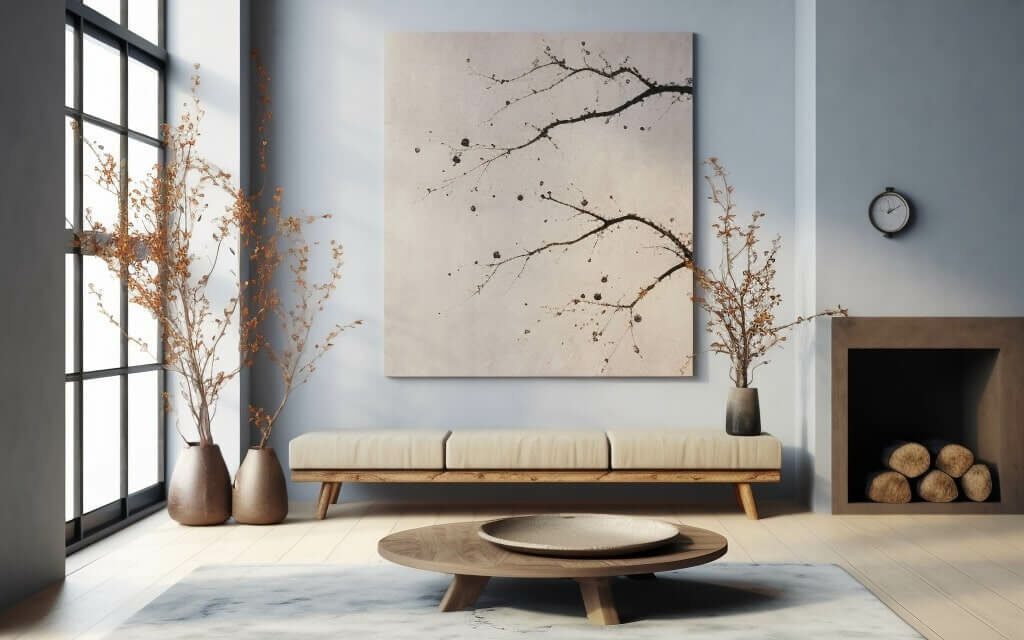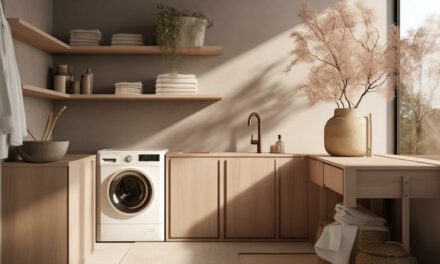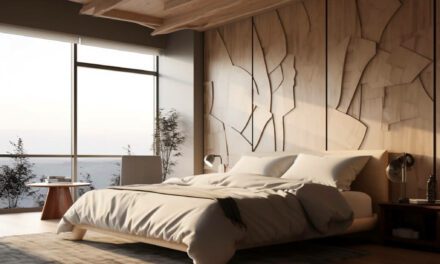If you’re seeking to infuse your home with a blend of tranquility, functionality, and minimalistic elegance, then you’ve probably stumbled across the term “Japandi.”
Today, I want to introduce you to an essential part of this style that often gets overlooked: Japandi rugs.
Japandi is an innovative aesthetic that fuses the best elements of Japanese and Scandinavian design.
The style is characterized by its minimalist approach, muted color palettes, natural materials, and the delicate balance between function and aesthetics.
In the heart of this blend lies the Japandi rug. These rugs are more than mere floor coverings; they’re statement pieces that anchor the room and provide a visual illustration of the Japandi ethos.
A Japandi rug is typically characterized by earthy tones, understated patterns, and a harmonious blend of natural materials.
It subtly connects each element in your space, creating a seamless flow of tranquility and warmth.
Think of it as the gentle whisper that pulls together the powerful, serene song that is a Japandi-styled room.
Throughout this article, we will dive into the captivating world of Japandi rugs. We will begin by exploring the essence of the Japandi style, discussing how it gracefully marries Japanese and Scandinavian design principles.
Then, we’ll delve into the unique art of Japandi rugs, exploring the materials, patterns, and colors that give them their distinctive character.
Choosing the perfect Japandi rug can be a rewarding adventure, and I’m here to guide you through it.
We’ll discuss the key considerations when selecting your rug, and how to determine its quality and longevity.
Furthermore, I will offer you practical tips on choosing the ideal Japandi rug for every room in your Japandi house, ensuring that each space radiates the serene, sophisticated charm inherent to this style.
Lastly, I’ll share my go-to retailers for sourcing quality Japandi rugs, and tips on finding a high-quality rug that offers good value for money.
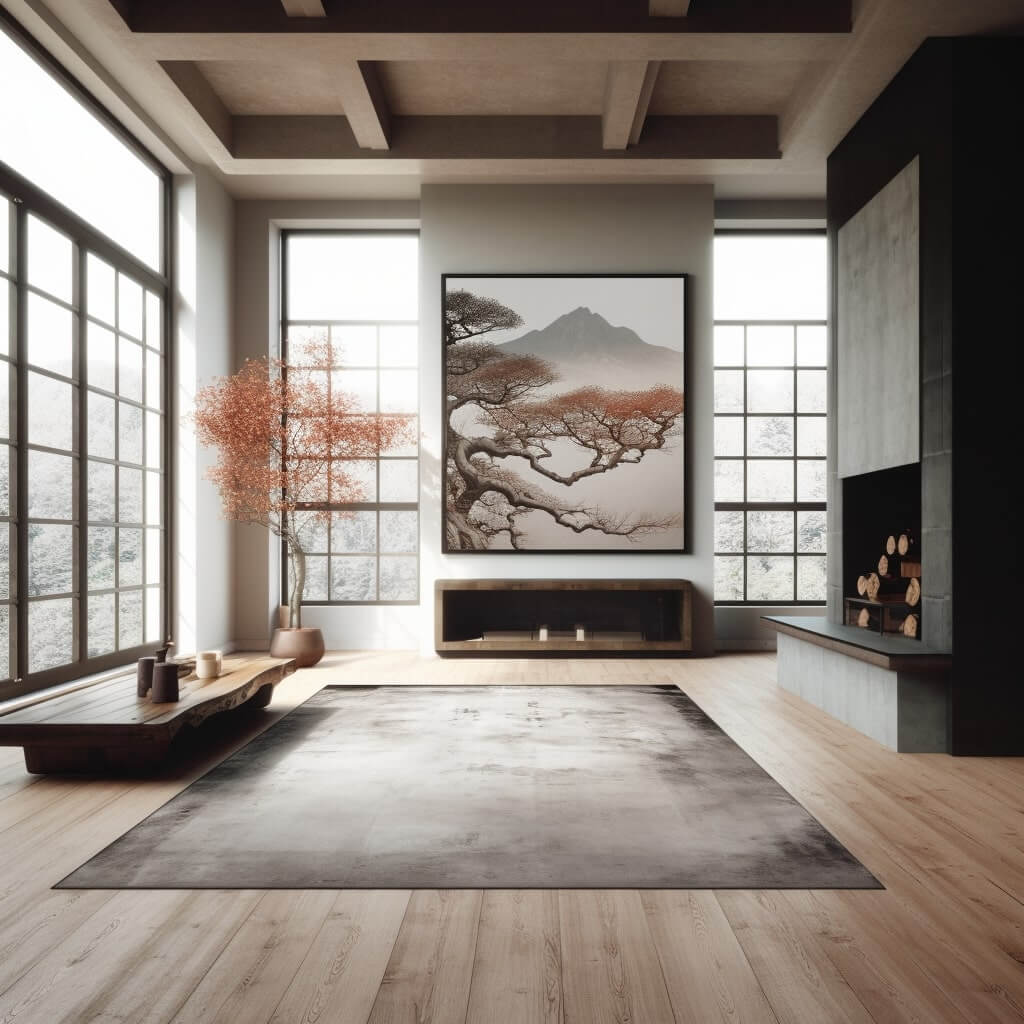
The Japandi style
If you asked me to describe the Japandi style in three words, I would choose simplicity, functionality, and harmony.
These principles, which are at the heart of both Japanese and Scandinavian design philosophies, converge to create an aesthetic that is both warm and minimalistic, serene yet functional, and striking in its restrained elegance.
The beauty of the Japandi style lies in its unique fusion of Japanese and Scandinavian elements.
From the Japanese side of things, it borrows the concepts of Wabi-Sabi and Ma. Wabi-Sabi embraces the beauty of imperfection and transience, celebrating natural materials with their perfect imperfections.
Ma, on the other hand, refers to the thoughtful use of space.
It’s about creating moments of calm and serenity within your surroundings, striking a balance between filled and empty space.
From the Scandinavian side, Japandi adopts the principles of hygge (pronounced hue-guh), lagom, and the overarching theme of functional minimalism.
Hygge is a Danish concept centered around coziness and comfortable conviviality, while lagom is a Swedish philosophy of balance and moderation – not too little, not too much, but just right.
The minimalism of Scandinavian design works in harmony with the Japanese appreciation for empty space, while the comfort of hygge complements the natural serenity of Wabi-Sabi.
Thus, Japandi creates a perfect synergy – combining the Scandinavian love for light, airy spaces and functional design with the Japanese emphasis on craftsmanship, natural materials, and tranquility.
Japandi style evokes a calming atmosphere with its muted color palette, primarily composed of earthy, neutral tones.
The occasional use of dark, contrasting hues and pops of green (often from indoor plants) adds depth and character to the design.
In Japandi-styled interiors, every piece of Japandi furniture, including our spotlight today, the Japandi rug, has its purpose and place.
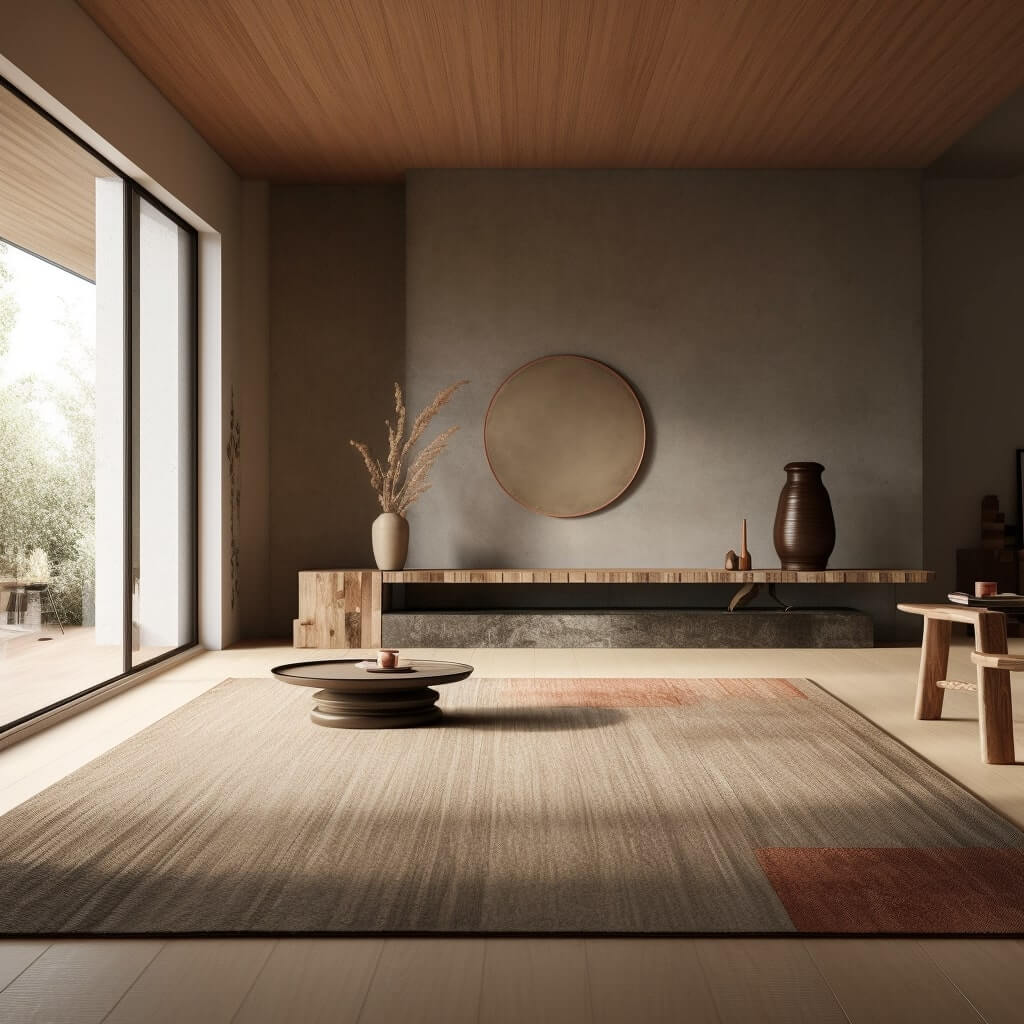
The Art of Japandi Rugs
They are chosen not just for their aesthetic appeal, but also for their function, quality, and the warmth they bring to the space.
In the intricate tapestry of interior design, rugs can be a defining factor that anchors the room, adding personality, warmth, and a sense of completeness.
And when it comes to Japandi rugs, they are much more than mere decorative pieces. They are a reflection of the design philosophy that fuses Scandinavian functionality with Japanese minimalism.
What sets Japandi rugs apart is their embodiment of the essential principles of the Japandi aesthetic.
The rugs are typically woven from natural, durable materials, like wool, cotton, or jute, echoing the love for nature inherent in both Japanese and Scandinavian design.
The quality of craftsmanship is also highly valued, with a preference for handmade or sustainably made pieces that ensure durability and longevity.
The color palette of Japandi rugs aligns seamlessly with the overall Japandi aesthetic. Muted, earthy tones dominate, including shades of beige, grey, brown, and off-white.
These colors are sometimes accompanied by deeper, contrasting hues like indigo or black, or accented with subtle pops of pastel colors or botanical greens.
The goal is to create a rug that feels harmonious and calming, mirroring the tranquil ambiance of a Japandi-styled space.
When it comes to patterns, Japandi rugs lean towards the minimalist end.
Simple, understated designs prevail, often inspired by nature or abstract geometric forms.
These patterns exude a sense of serenity and balance without distracting from the overall calm of the room.
In terms of placement and purpose, a Japandi rug serves to visually ground the room, define the space, and add a layer of comfort and warmth.
Despite its often understated design, a Japandi rug is a key player in the overall aesthetic.
It provides a subtle visual focus that ties together the furniture and decor, creating a cohesive, harmonious space that feels both inviting and relaxing.
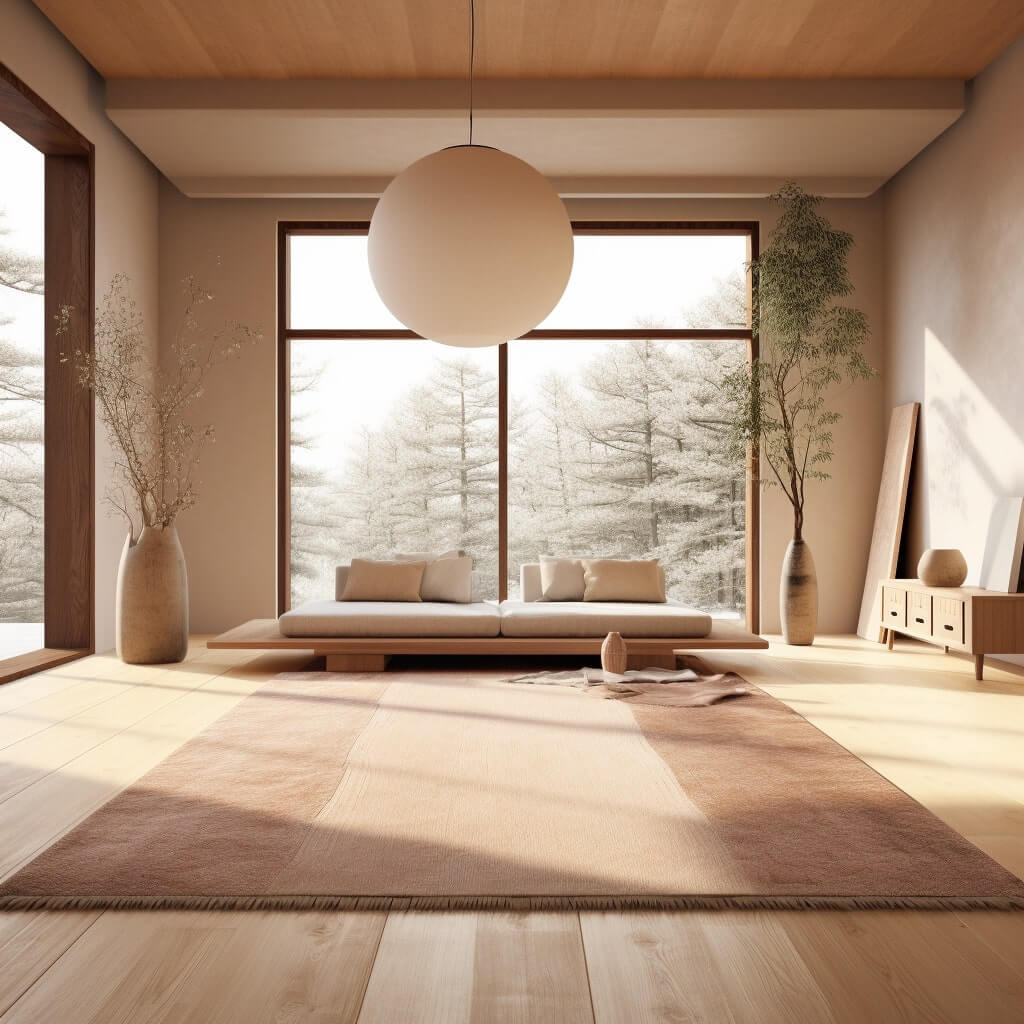
How to Choose Your Japandi Rug
Choosing a Japandi rug for your home is much more than picking an attractive piece of decor.
It’s about finding a rug that beautifully complements your space, aligns with your aesthetic preferences, and stays true to the Japandi principles of simplicity, functionality, and harmony.
Firstly, consider the size of the rug. The dimensions should be proportional to the room and the furniture within it.
In a Japandi-style space, a rug often serves to define and ground a specific area, like a seating arrangement in the living room or the bed in a bedroom.
A small rug might look lost in a large room, while an oversized one could overwhelm the space.
The color of your Japandi rug should typically fall within the muted, earthy palette that characterizes the Japandi style.
Neutral tones like beige, grey, and off-white are common, often complemented by darker hues like indigo or black for contrast.
However, the choice ultimately depends on your room’s color scheme and your personal taste.
When it comes to pattern, opt for simple, understated designs that exude tranquility and balance.
Remember, Japandi is about embracing minimalism and appreciating the beauty in simplicity.
Material choice is also crucial. Japandi rugs are often made from natural materials like wool, cotton, or jute, reflecting the style’s affinity for nature and sustainability.
These materials not only contribute to the rug’s aesthetic appeal but also its comfort and durability.
Determining the quality of a Japandi rug involves examining its craftsmanship.
Look for rugs that are handmade or sustainably made, as these often guarantee better quality and longevity.
Check the tightness of the weave, the evenness of the edges, and the consistency of the pattern.
Speaking of longevity, a well-made Japandi rug can last for years, if not decades, with proper care.
Regular vacuuming to remove dust and debris, immediate attention to spills, and professional cleaning when necessary can help maintain its appearance and extend its lifespan.
In our next section, we’ll delve into the exciting process of selecting a Japandi rug for each room in your home.
As we continue our journey into the world of Japandi rugs, remember that the perfect choice is not only about aesthetics but also about quality, sustainability, and harmony with your space.
Japandi Rugs For Each Room
Living Room
Size is crucial here for a Japandi living room.
A common rule of thumb is to choose a rug large enough so that all the furniture sits on it or at least the front legs of your furniture.
The color and pattern of the rug should complement your furniture and overall color scheme.
Consider the rug’s texture as well, as it contributes to the comfort and coziness of the space – crucial for a room where relaxation is key.
Bedroom
In the Bedroom, tranquility is paramount.
The rug should echo this peacefulness.
Placing a soft, plush rug underfoot can be a comforting start to your day.
Opt for soothing colors and minimalist patterns that align with your bedding and wall colors.
Size-wise, a common approach is to have a large rug under the bed, extending out on both sides for symmetry.
Dining Room and Kitchen
Look for a rug that’s durable and easy to clean.
Natural materials like wool or jute are excellent choices as they are hard-wearing and hide minor stains well.
For the dining room, ensure that the rug is large enough to accommodate all chairs, even when they’re pulled out.
In the kitchen, a runner rug works well, providing comfort underfoot while cooking. Runner rugs also work well in a lovely Japandi entryway.
Other Rooms
When it comes to other areas like the hallway, office, or outdoor spaces, remember to consider the purpose of the rug and the characteristics of the space.
A hallway rug, for example, should be durable to withstand high foot traffic.
An office rug can add a touch of comfort and warmth to your workspace.
If you’re considering a Japandi rug for an outdoor area, ensure it’s made of materials suitable for outdoor use.
Where to buy Japandi Rugs
Today, an array of online retailers offer a great selection of Japandi rugs.
Etsy is a fantastic platform for finding handmade, unique Japandi rugs from artisans around the world.
For sustainable options, Made Trade is an excellent choice, offering a range of ethically sourced, handcrafted rugs that align with the Japandi aesthetic.
Rugs.com and Wayfair also provide an extensive variety of options in terms of color, pattern, and size.
If you prefer to touch and feel your rug before purchasing, Offline Retailers like IKEA and Muji offer selections that often align with the Japandi style.
Their products combine functionality with simple, clean design, making them ideal choices for Japandi rugs.
When it comes to finding a quality rug at a fair price, here are a few tips.
First, do your research. Understand the average price range for the type of rug you’re looking for.
Second, remember that the material and craftsmanship influence the price. Handmade rugs or those made from high-quality natural materials may be pricier, but they often offer greater longevity.
Lastly, be patient and watch for sales. Many online retailers regularly offer discounts, and waiting for these can lead to substantial savings.
FAQs
What is the best rug for Japandi style?
The best rug for Japandi style is one that embraces simplicity, functionality, and natural elements. It should feature a muted, earthy color palette, be made from natural materials like wool, cotton, or jute, and have a minimalist, harmonious pattern.
What is the difference between Scandi and Japandi?
While both Scandi and Japandi design prioritize simplicity and functionality, Japandi stands out with its fusion of Japanese Wabi-Sabi (beauty in imperfection) and Ma (thoughtful use of space) principles, resulting in an aesthetic that’s more balanced, warm, and serene.
What is Japandi style?
Japandi style is a design aesthetic that combines elements of Japanese and Scandinavian design philosophies. It emphasizes simplicity, functionality, natural elements, and harmony, often featuring a muted color palette, minimalist patterns, and a blend of light and dark tones.
What are the materials used in Japandi rugs?
Japandi rugs are typically made from natural, durable materials that reflect the style’s affinity for nature and sustainability. Common materials include wool, cotton, and jute. These not only contribute to the rug’s aesthetic appeal but also offer comfort underfoot and ensure durability.
What is the best flooring for Japandi?
The best flooring for Japandi style is natural and neutral-toned. Light wood flooring is a popular choice due to its simplicity, warmth, and ability to reflect light, enhancing the sense of space and serenity. However, natural stone or matte tiles can also work well.
What are Scandinavian rugs called?
Scandinavian rugs, known as “rya” or “rölakan,” are traditional hand-knotted or flat-weave wool rugs. They are characterized by minimalist patterns, natural materials, and a color palette that ranges from earthy tones to bright, contrasting hues.
What kind of rugs do interior designers use?
Interior designers often use rugs that complement the overall design aesthetic of a room. They may choose from a variety of styles, materials, and patterns, including but not limited to Japandi, Scandinavian, Bohemian, Modern, and Persian, based on the space and client’s preferences.
What is an Oslo rug?
An Oslo rug, often associated with Scandinavian design, is typically a handmade, wool rug. It can feature geometric patterns, minimalist designs, and a neutral color palette, embodying the simplicity, functionality, and cozy warmth of Scandinavian interiors.







